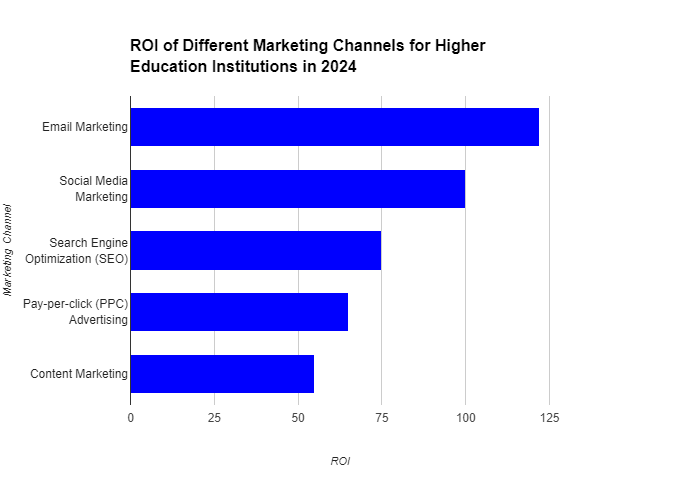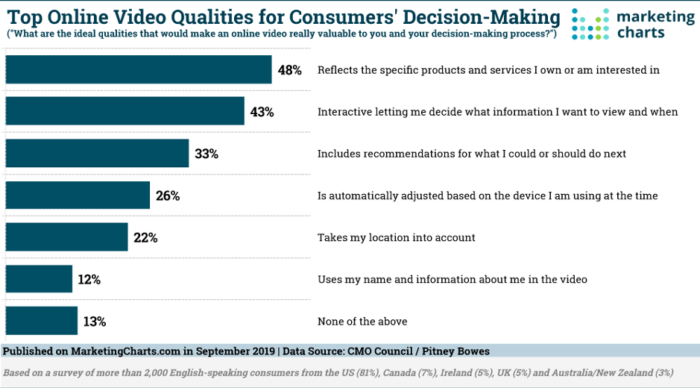Higher education marketing stands at the intersection of tradition and innovation, continually adapting to the dynamic landscape of student recruitment.

Higher education marketing stands at the intersection of tradition and innovation, continually adapting to the dynamic landscape of student recruitment.
As we approach 2024, institutions are compelled to reassess their strategies, harnessing the power of digital advancements and emerging trends to resonate with the ever-evolving preferences of prospective students.
In this era of unprecedented connectivity, the importance of staying ahead of marketing trends cannot be overstated. Latest reports from the Education Marketing Industry offer profound insights into the pivotal shifts awaiting higher education institutions. With a projected global higher education market value of USD 44,951.96 million by 2028, the stakes are high, urging institutions to not only survive but thrive in this competitive landscape.
As we dig into the trends shaping higher education marketing in 2024, the data speaks volumes. Digital marketing, constituting an average of 12% of total budgets, is a dominant force. The allocation is strategic, with 98% prioritizing websites, 95% leveraging email marketing, and 92% engaging in social media marketing. These channels, backed by the latest statistics, underscore the essentiality of a robust digital presence.

Video marketing emerges as a focal point, with a projected 15% growth in 2024. It’s not just a tool but a necessity, influencing 72% of prospective students in their application decisions. The global international student market, expected to reach USD 21.3 billion by 2028, necessitates a shift towards multilingual marketing and targeted outreach.
In this intricate dance of data and strategy, institutions must equip themselves with a nuanced understanding of the trends that will define 2024. This exploration seeks to unveil these trends, guiding institutions toward a future where innovation and adaptability are the cornerstones of successful higher education marketing.
Digital Dominance: The Core of Higher Education Marketing
In the fast-evolving landscape of higher education marketing, digital channels stand tall as the bedrock of institutions’ outreach strategies. The pivotal role of digital marketing is underscored by the commitment of higher education institutions to invest an average of 12% of their total budgets in digital initiatives in 2024.

These figures, gleaned from the latest reports in the Education Marketing Industry, affirm the imperative for institutions to harness the full spectrum of digital tools for effective student engagement. Digital marketing spending in 2024 is not just a mere allocation; it’s a strategic deployment of resources aimed at maximizing impact.
The breakdown of the digital marketing budget allocation reveals a nuanced approach, with 98% of institutions prioritizing their websites, 95% leveraging email marketing, and 92% actively engaging in social media marketing. These statistics underscore the undeniable importance of a strong online presence, recognizing websites, email, and social media as linchpins in the digital marketing arsenal.
In the realm of essential digital strategies, Search Engine Optimization (SEO) emerges as a cornerstone for higher education institutions. SEO is not merely a technical optimization exercise but a strategic imperative to enhance online visibility.
Institutions in 2024 are meticulously crafting their online content, ensuring that websites are optimized for relevant keywords and search terms. This proactive SEO approach aligns with the modern digital landscape, where prospective students rely on search engines to explore and discover higher education options.
Social Media Marketing (SMM) continues to be a driving force in the digital marketing landscape. With 80% of higher education institutions actively using social media, it has become an indispensable tool for connecting with prospective students.

The power of platforms like Instagram (78%), YouTube (67%), and Facebook (62%) is harnessed to share news, events, and student stories. Social media has transcended its role as a mere communication channel; it has become a dynamic space for institutions to build their brand and engage with the student community.
Email Marketing, often hailed as a stalwart in the digital marketing arsenal, maintains its effectiveness with an average Return on Investment (ROI) of 122%. In 2024, institutions are leveraging personalized email campaigns to connect with prospective students.
The segmentation of email lists ensures tailored communication, delivering the right messages to the right audience. This personalized approach not only fosters engagement but also contributes significantly to the overall success of email marketing campaigns.
Mobile Marketing emerges as a strategic imperative, reflecting the shift in how prospective students access information. With mobile devices becoming the primary medium for accessing information about colleges and universities, institutions are adapting their strategies.
SMS messaging and push notifications are employed to reach prospective students effectively. The optimization of websites and marketing materials for mobile devices is non-negotiable in an era where accessibility and responsiveness define user experience.
Emerging Technologies, particularly Artificial Intelligence (AI) and Machine Learning (ML), are not just buzzwords but integral components of higher education marketing in 2024. Institutions are deploying AI-driven chatbots to answer student queries and provide support.
Personalized marketing recommendations, predictive analytics for identifying prospective students likely to apply, and automated email marketing campaigns underscore the transformative potential of AI and ML in the higher education marketing landscape.
The Power of Visuals: Video Marketing Takes Center Stage
Latest reports from the Education Marketing Industry forecast a remarkable 15% growth in video marketing in 2024. This surge is not just a quantitative uptick but a testament to the qualitative impact that videos wield in influencing the choices of prospective students.

A staggering 72% of these students affirm that video content played a decisive role in their application decisions, signaling a paradigm shift in how institutions convey their unique value propositions.
The significance of video marketing lies in its unparalleled ability to provide an immersive experience. Institutions are strategically leveraging videos to showcase their campuses and facilities, offering a virtual tour that transcends traditional brochures. This visual storytelling extends beyond the physical infrastructure; it captures the essence of academic life, fostering a connection with prospective students.
Student testimonials, another powerful application of video content, serve as authentic voices that resonate with the target audience. When 68% of prospective students cite testimonials as influential in their decision-making process, it underscores the trust-building potential inherent in hearing the experiences of peers.
The human element conveyed through video testimonials creates a relatable narrative, establishing an emotional connection that goes beyond the institutional pitch.

Academic program explanations through video content cater to the evolving preferences of modern learners. The visual medium allows institutions to breathe life into abstract program descriptions, offering a tangible glimpse into the learning experience.
Potential students are not just presented with facts; they are invited into a visual narrative that elucidates the dynamic nature of academic pursuits.
Immersive storytelling about the institution’s community is a nuanced application of video marketing. Beyond facilities and programs, institutions are using videos to convey the vibrant community that defines their identity. Whether it’s capturing cultural events, collaborative initiatives, or faculty-student interactions, this storytelling transcends the conventional, painting a holistic picture of the institution’s ethos.
The strategic integration of video marketing into higher education outreach is not a mere trend; it’s a responsive strategy to the evolving preferences of the target audience. It aligns with the modern student’s inclination towards visual content as a primary source of information.
As the data suggests, 90% of institutions in 2024 are recognizing the potential of video marketing and are poised to harness its transformative power.
Personalization Matters: Tailoring Messages to Individual Students
In crafting effective higher education marketing strategies for 2024, personalization emerges as a key determinant of success.
![Higher Education Marketing 2023 and Beyond [Detailed Analysis], Higher Education Marketing, Education Marketing, Education PR, Digital PR, Public Relations, Digital Marketing, social media, SEO for Higher Education, Digital Marketing for Higher Education](https://firdoshkhan.in/wp-content/uploads/2022/11/Online-Program-Higher-Education-Markrting-.jpg)
The landscape is evolving, and institutions are increasingly recognizing the imperative of tailoring messages to individual students. This commitment to personalization is not merely a trend; it’s a strategic response to the preferences of modern students and a data-driven approach to marketing.
The emphasis on personalization stems from a profound understanding that one size does not fit all in the diverse landscape of higher education. Institutions, armed with data-driven insights, are leveraging this knowledge to refine their marketing messages and create a more engaging and relevant experience for prospective students.
The data-driven approach is not just a buzzword; it’s a methodology that transforms raw information into actionable strategies, ensuring that each communication resonates with its intended audience.
Data, in this context, serves as the compass guiding institutions towards personalized marketing excellence. By leveraging student data, institutions can tailor their messages to align with individual preferences, academic interests, and aspirations. This extends beyond generic communications, leading to the creation of personalized emails, targeted ads, and relevant program recommendations.
Personalized emails, backed by a wealth of student data, represent a cornerstone of modern higher education marketing. The utilization of data ensures that each email is crafted with precision, delivering content that speaks directly to the recipient’s interests and needs.

The impact is palpable, with an average return on investment (ROI) of 122%, showcasing the effectiveness of a targeted and personalized email strategy.
Ads, in the age of personalization, transcend the generic and become strategic tools for engagement. Institutions are utilizing data to understand the online behaviors and preferences of prospective students, tailoring their ad campaigns to align with these insights.
This precision not only enhances the effectiveness of advertising efforts but also ensures that the institution remains at the forefront of the student’s decision-making journey.
Program recommendations, another dimension of personalized marketing, leverage data to guide prospective students towards academic offerings that align with their interests and career goals. This proactive approach is not just about promoting programs; it’s about facilitating a seamless and personalized exploration of academic pathways.
Successful personalized marketing campaigns are not just theoretical; they are exemplified through real-world case studies. Institutions across the globe are achieving remarkable results by harnessing the power of personalization.
Whether it’s a university sending targeted emails to prospective students based on their academic interests or a college tailoring its social media ads to resonate with the preferences of its audience, these examples underscore the transformative impact of personalized marketing.
Beyond Borders: International Student Recruitment
Recognizing the growing importance of global diversity and cross-cultural enrichment, international student recruitment has become a pivotal focus for higher education institutions.

In 2024, the imperative to extend beyond borders is not just a strategic choice; it is a necessity for institutions seeking to foster a globally inclusive and dynamic academic community.
The emphasis on recruiting international students is substantiated by compelling statistics from the Education Marketing Industry. The global higher education market, projected to reach USD 44,951.96 million by 2028, underscores the vast opportunities that international student recruitment presents for institutions.
Beyond the financial implications, institutions are increasingly recognizing the enriching impact of a diverse student body on campus culture and the overall academic experience.
Strategies for international student marketing extend beyond traditional outreach approaches. Multilingual marketing materials have become a cornerstone in this endeavor. Recognizing that language is a bridge to understanding, institutions are investing in materials that transcend linguistic barriers.
Brochures, websites, and promotional content are crafted in multiple languages, ensuring that prospective international students receive information in a language they are comfortable with.
Building relationships with international schools and organizations is another vital strategy in the toolkit of institutions. Recognizing the influence that these entities wield in guiding students towards higher education opportunities, institutions are establishing partnerships and collaborations.

This collaborative approach not only amplifies the institution’s reach but also fosters a network that supports prospective international students in their academic journey.
Statistics on the global international student market provide a comprehensive understanding of the landscape. With the global international student market expected to reach USD 21.3 billion by 2028, institutions are poised to tap into this vast reservoir of talent.
The top destinations for international students include the United States, the United Kingdom, Australia, Canada, and Germany. These statistics not only guide institutions in tailoring their marketing strategies but also highlight the competitive nature of international student recruitment.
In essence, international student recruitment in 2024 is not just about expanding the geographical reach of institutions; it’s about embracing a global perspective that enriches the entire academic community.
The strategies employed, from multilingual marketing materials to building collaborative relationships, reflect a nuanced understanding of the unique challenges and opportunities in international student recruitment. Beyond the financial considerations, the recruitment of international students contributes to the cultural vibrancy of institutions, fostering an environment where diverse perspectives thrive.
As institutions navigate the complexities of global competition for talent, the commitment to international student recruitment is not just a strategic move; it is a commitment to fostering a dynamic, inclusive, and globally connected academic ecosystem.
To Conclude
In the competitive landscape of higher education marketing in 2024, several key trends emerge as instrumental for institutional success. Digital dominance prevails, with institutions allocating 12% of their budgets to digital marketing channels, emphasizing the critical role of SEO, SMM, and email marketing.
Video marketing takes center stage, projected to grow by 15%, influencing 72% of prospective students in their application decisions. Personalization becomes paramount, with data-driven approaches facilitating tailored messages through emails, ads, and program recommendations, yielding an average ROI of 122%.
The global pursuit of talent is underscored by a projected USD 21.3 billion international student market by 2028, necessitating multilingual marketing materials and strategic partnerships.
Institutions must adapt to these trends for sustainable success. The call to action is clear: embrace innovation, leverage data, and foster a global mindset. Those who integrate these trends into their marketing strategies will not only thrive but also shape the future landscape of higher education.
Also Read:
The Impact of Internationalization on Higher Education Marketing?
How to Measure the Effectiveness of Your Higher Education Marketing Efforts
The Benefits of Collaborating with Other Higher Education Institutions for Marketing Purposes?



Pingback: Why Educational Marketing Trumps Selling in Crises?
Pingback: LinkedIn Thought Leadership Strategies For Higher Ed Marketing
Pingback: Education Marketing in 2024: Meaning, Significance, and Benefits